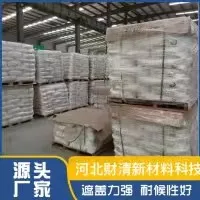
Jul . 21, 2025 10:42 Back to list
Optical Properties and Light Interaction of Titanium Dioxide
When examining the optical performance of rutile versus anatase titanium dioxide, the refractive index emerges as a key differentiator. Rutile titanium oxide boasts a refractive index of 2.7, significantly higher than anatase's 2.55. This property directly translates to superior light-scattering capability, making rutile titanium dioxide pigment the preferred choice when opacity and hiding power are primary requirements. In practical terms, this means paint formulations using rutile TiO₂ can achieve the same coverage with less pigment loading compared to those using anatase.

The interaction with ultraviolet light reveals another critical distinction between these two forms. While both rutile and anatase titanium dioxide absorb UV radiation, they do so with different efficiency spectra. Anatase shows stronger absorption in the UV-A range (315-400 nm), making it theoretically better for UV protection. However, rutile titanium dioxide provides broader UV absorption across both UV-A and UV-B (280-315 nm) ranges, and crucially, it does so without generating as many reactive oxygen species. This makes rutile TiO₂ safer for applications where photocatalytic degradation of surrounding materials must be minimized, such as in plastics and coatings.
The whiteness and brightness characteristics also differ noticeably. Anatase titanium dioxide typically appears slightly bluer and brighter in mass tone, which might suggest superior performance. However, when dispersed in media, rutile titanium oxide generally provides better actual hiding power due to its higher refractive index. This paradox explains why anatase sometimes finds use in paper applications where surface brightness is prioritized, while rutile dominates in paint systems where true opacity matters more.
Titanium Dioxide Photocatalytic Activity: A Double-Edged Sword
The photocatalytic behavior of rutile and anatase titanium dioxide presents one of their most significant functional differences. Anatase TiO₂ demonstrates markedly higher photocatalytic activity, making it the preferred choice for applications like self-cleaning surfaces, air purification systems, and antimicrobial coatings. The more open crystal structure of anatase titanium dioxide facilitates the generation of electron-hole pairs when exposed to UV light, which then react with surface moisture to create reactive oxygen species. These radicals can break down organic pollutants, microbes, and even some inorganic compounds.
Conversely, rutile titanium oxide exhibits much lower photocatalytic activity due to its more stable crystal lattice and faster electron-hole recombination rate. While this might seem like a disadvantage, it actually makes rutile titanium dioxide pigment far superior for applications where material stability is crucial. In exterior paints, for instance, high photocatalytic activity would cause the binder system to degrade prematurely. Similarly, in plastic applications, anatase TiO₂ could accelerate polymer degradation through photocatalytic reactions, while rutile TiO₂ provides stable coloration without compromising material integrity.
Interestingly, some advanced applications combine rutile and anatase titanium dioxide in specific ratios to balance photocatalytic activity with stability. These mixed-phase systems attempt to harness anatase's reactivity while mitigating its drawbacks through the stabilizing presence of rutile. Such formulations require precise engineering to ensure the desired performance characteristics are achieved without unintended side effects.
Titanium Dioxide Industrial Applications: Divergent Paths
The practical applications of rutile versus anatase titanium dioxide have evolved along distinctly different paths, reflecting their inherent properties. Rutile titanium dioxide pigment dominates the coatings industry, particularly for exterior applications where durability and weather resistance are paramount. Its superior opacity, UV resistance, and binder compatibility make it indispensable for architectural paints, automotive finishes, and industrial coatings. Approximately 90% of titanium dioxide used in paint formulations worldwide is the rutile form.
Anatase titanium dioxide finds its niche in applications where its specific properties offer advantages. The paper industry frequently prefers anatase for certain grades where its brighter appearance and lower abrasiveness benefit the final product. Some specialized photocatalytic applications, such as self-cleaning glass or air purification systems, deliberately select anatase TiO₂ for its higher reactivity. The textile industry sometimes chooses anatase for fiber applications where its different surface characteristics provide better processability.
In plastics, the choice between rutile and anatase titanium dioxide depends largely on the polymer type and end-use environment. For outdoor plastic products or those requiring long-term stability, rutile titanium oxide is universally preferred. However, some indoor plastic applications with special optical requirements might use anatase, provided the formulation includes sufficient stabilizers to counteract its photocatalytic activity.
-
Application of Titanium Dioxide 2195 in Water Purification
NewsNov.14,2025
-
What are the global market trends of Titanox titanium dioxide in recent years
NewsNov.14,2025
-
Effect of particle size distribution on the optical properties of R996 TiO2
NewsNov.14,2025
-
Latest Technological Innovations in Rutile Titanium Dioxide Manufacturing
NewsNov.14,2025
-
Compatibility of Titanium Dioxide Concrete Pigment with Different Concrete Admixtures
NewsNov.14,2025
-
Environmental Impact of Titanium Dioxide Pigment Manufacturing and Mitigation Measures
NewsNov.14,2025
